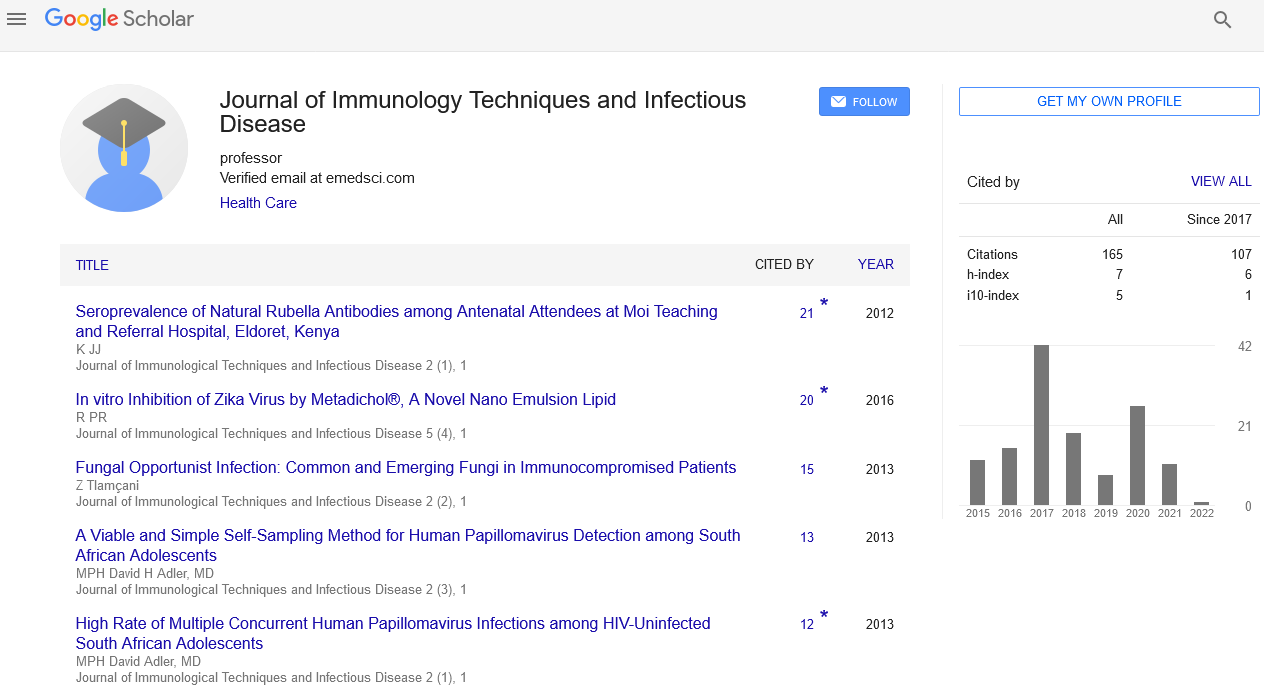Short Communication, J Immunol Tech Infect Dis Vol: 13 Issue: 3
Pediatric Infections: A Comprehensive Overview of Common Illnesses and Management
Scott Ochoa*
1Department of Child Health and Development, University of Arizona, Arizona, United States of America
*Corresponding Author: Scott Ochoa,
Department of Child Health and
Development, University of Arizona, Arizona, United States of America
E-mail: ochoascott@gmail.com
Received date: 26 August, 2024, Manuscript No. JIDIT-24-151942;
Editor assigned date: 28 August, 2024, PreQC No. JIDIT-24-151942 (PQ);
Reviewed date: 11 September, 2024, QC No. JIDIT-24-151942;
Revised date: 18 September, 2024, Manuscript No. JIDIT-24-151942 (R);
Published date: 25 September, 2024, DOI: 10.4172/2329-9541.1000386
Citation: Ochoa S (2024) Pediatric Infections: A Comprehensive Overview of Common Illnesses and Management. J Immunol Tech Infect Dis 13:3.
Description
Pediatric infections, encompassing a variety of microbial illnesses, represent a significant concern in child healthcare. Children, especially those under five years of age, are particularly vulnerable to infections due to their developing immune systems, frequent exposure to other children and lack of prior immunity to many pathogens. The risk of these infections, their severity and the treatment method differ from those in adults, demonstrating the need for specialized knowledge in pediatric infectious diseases. This study explores the common types of pediatric infections, their symptoms, treatments and preventive measures to protect children’s health [1,2].
Respiratory infections
Respiratory infections are among the most common infections seen in pediatric populations. These infections, affecting the respiratory tract, can range from mild cases of the common cold to more serious conditions such as pneumonia and bronchiolitis. Common pathogens include viruses such as Respiratory Syncytial Virus (RSV), influenza, rhinovirus and bacteria such as Streptococcus pneumonia.
Common cold and influenza: The common cold, frequently caused by rhinovirus, manifests with symptoms such as sneezing, sore throat, cough and runny nose. Though usually mild, colds can be troublesome and may lead to secondary infections like sinusitis or ear infections. Influenza, commonly known as the flu, is more severe, presenting with high fever, body aches, fatigue and cough. Vaccination remains one of the most effective preventive measures for influenza, while colds are typically managed with supportive care [3,4].
Pneumonia and bronchiolitis: Pneumonia can be caused by both viruses and bacteria and it results in inflammation of the lung tissue. Common symptoms include difficulty breathing, cough, fever and chest pain. RSV is a leading cause of bronchiolitis in infants, a condition where the small airways of the lungs become inflamed, leading to wheezing and labored breathing. Treatment for pneumonia may include antibiotics for bacterial causes, while bronchiolitis is usually managed with supportive care, such as hydration and oxygen therapy [5].
Gastrointestinal infections
Gastrointestinal (GI) infections in children can lead to diarrhea, vomiting, abdominal pain and dehydration, which can be particularly severe in young children. Common pathogens include rotavirus, norovirus, Escherichia coli (E. coli) and Salmonella. Rotavirus is historically a major cause of severe diarrhea in babies, but with the development of the rotavirus vaccination, its prevalence has significantly decreased [6-8].
Symptoms and management
Gastrointestinal infections frequently present with acute onset of diarrhea, vomiting and abdominal cramps and sometimes fever. Children with GI infections, especially those experiencing dehydration, require careful management, it usually includes rehydration with Oral Rehydration Solutions (ORS) or, in severe cases, intravenous fluids. Antibiotics may be indicated in bacterial cases, such as severe Salmonella or E. coli infections, but are generally avoided in viral infections due to their lack of effectiveness. Otitis media or middle ear infection is particularly common among infants and young children. It occurs when bacteria or viruses infect the middle ear, leading to fluid buildup behind the eardrum. Otitis media can cause ear pain, fever, irritability and in some cases, temporary hearing loss. Children are more prone to ear infections due to their shorter and more horizontal Eustachian tubes, which can more easily become blocked [9,10].
Diagnosis and treatment
Diagnosis is usually made through otoscope; it is a procedure that allows the physician to examine the eardrum. Antibiotics are commonly used if a bacterial infection is suspected, especially if the child has severe symptoms or is under six months old. However, in some cases with mild symptoms, observation is frequently recommended to avoid overuse of antibiotics. Pain management may include acetaminophen or ibuprofen.
Preventive measures
Good hygiene, including hand washing and proper food preparation, plays an essential role in preventing gastrointestinal infections. Vaccination for rotavirus has proven highly effective in reducing the incidence of severe rotavirus gastroenteritis and it is now part of the recommended immunization schedule in many countries. Vaccines against pathogens such as Haemophilus Influenzae Type B (Hib) and Streptococcus pneumoniae have contributed to decrease the incidence of otitis media. Avoiding secondhand smoke, breastfeeding and minimizing pacifier use have also been shown to reduce the risk of ear infections.
References
- Bakowski MA, Braun V, Lam GY, Yeung T, Heo WD, et al. (2010) The phosphoinositide phosphatase SopB manipulates membrane surface charge and trafficking of the Salmonella-containing vacuole. Cell Host Microbe 7:453-462.
[Crossref] [Google Scholar] [PubMed]
- Rajabian T, Gavicherla B, Heisig M, Altrock SM, Goebel W, et al. (2009) The bacterial virulence factor InlC perturbs apical cell junctions and promotes cell-to-cell spread of Listeria. Nat Cell Biol 11:1212-1218.
[Crossref] [Google Scholar] [PubMed]
- Vergne I, Chua J, Lee HH, Lucas M, Belisle J, et al. (2005) Mechanism of phagolysosome biogenesis block by viable Mycobacterium tuberculosis. Proc Natl Acad Sci U S A 102:4033-4038.
[Crossref] [Google Scholar] [PubMed]
- Ensminger AW (2016) Legionella pneumophila, armed to the hilt: justifying the largest arsenal of effectors in the bacterial world. Curr Opin Microbiol 29:74-80.
[Crossref] [Google Scholar] [PubMed]
- Sieczkarski SB, Whittaker GR (2002) Dissecting virus entry via endocytosis. J Gen Virol 83:1535-1545.
[Crossref] [Google Scholar] [PubMed]
- Nicola AV, McEvoy AM, Straus SE (2003) Roles for endocytosis and low pH in herpes simplex virus entry into HeLa and Chinese hamster ovary cells. J Virol 77:5324-5332.
[Crossref] [Google Scholar] [PubMed]
- Lakadamyali M, Rust MJ, Zhuang X (2004) Endocytosis of influenza viruses. Microbes Infect 6:929-936.
[Crossref] [Google Scholar] [PubMed]
- Sundquist WI, Kräusslich HG (2012) HIV-1 assembly, budding and maturation. Cold Spring Harb Perspect Med 2:a006924.
[Crossref] [Google Scholar] [PubMed]
- Schelhaas M, Shah B, Holzer M, Blattmann P, Kuhling L, et al. (2012) Entry of human papillomavirus type 16 by actin-dependent, clathrin-and lipid raft-independent endocytosis. PLoS Pathog 8:e1002657.
[Crossref] [Google Scholar] [PubMed]
- Shi Y, Zhang W, Wang F, Qi J, Wu Y, et al. (2013) Structures and receptor binding of hemagglutinins from human-infecting H7N9 influenza viruses. Science 342:243-247.
[Crossref] [Google Scholar] [PubMed]
 Spanish
Spanish  Chinese
Chinese  Russian
Russian  German
German  French
French  Japanese
Japanese  Portuguese
Portuguese  Hindi
Hindi 
